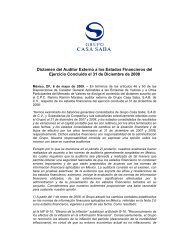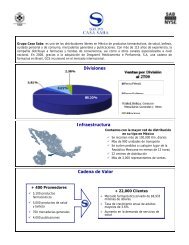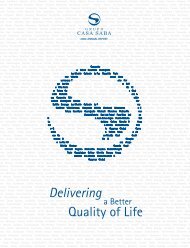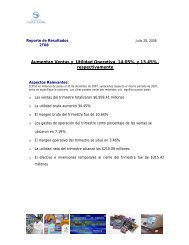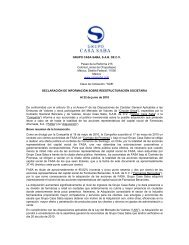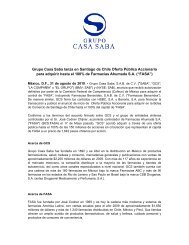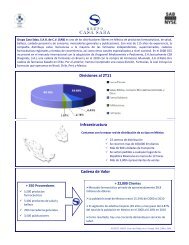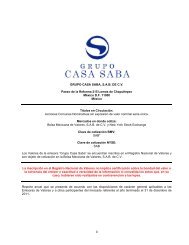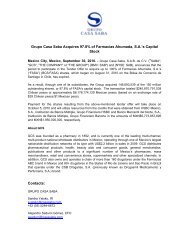FORM 20-F Grupo Casa Saba, S.A.B. de C.V.
FORM 20-F Grupo Casa Saba, S.A.B. de C.V.
FORM 20-F Grupo Casa Saba, S.A.B. de C.V.
Create successful ePaper yourself
Turn your PDF publications into a flip-book with our unique Google optimized e-Paper software.
Table of Contents<br />
Effective <strong>20</strong>11, the Group adopted retrospectively the new Mexican FRS C-5, “Prepaid expenses” that superse<strong>de</strong>s the Bulletin with the same name. Accordingly, prepaid expenses are<br />
presented as a current asset when the period in which their benefits are expected to be obtained is equal to or less than one year. Prepaid expenses for goods are presented in the shortterm<br />
or long-term, <strong>de</strong>pending on the classification of the item inten<strong>de</strong>d (e.g.: inventory or property and equipment). That adoption had no impact on the consolidated financial<br />
statements.<br />
i) Financial instruments<br />
The carrying value of all financial assets and financial liabilities that is <strong>de</strong>rived from any type of financial instrument is assessed at its estimated fair value and it is recognized in the<br />
balance sheet. The valuation effect, as well as costs and returns generated by financial instruments, form part of the comprehensive gain or loss on financing when incurred or earned.<br />
At December 31, <strong>20</strong>11 and <strong>20</strong>10, the carrying value of financial instruments (cash, receivables, other accounts receivable, tra<strong>de</strong> accounts payable, other payables and accrued liabilities,<br />
as well as short-term <strong>de</strong>bt) approximates their estimated fair value due to their short-term nature. The valuation of the long-term <strong>de</strong>bt incurred through bank loans and market bonds<br />
consi<strong>de</strong>rs estimated values for financial instruments with similar terms and due dates existing on the market, which accrue variable financing rates in effect on the market.<br />
j) Derivative financial instruments<br />
These transactions are contracted to significantly hedge the associated risks with changes in interest rate, exchange rate or inflation. The <strong>de</strong>signation of hedges is documented by<br />
<strong>de</strong>scribing the strategy and objective of management of risks, hedged risks, i<strong>de</strong>ntification of the hedged primary position, its accounting recognition, and how its effectiveness is<br />
measured. Management estimates that the changes in cash flows of the <strong>de</strong>rivative financial instrument maintain high effectiveness in offsetting the changes in cash flows of the<br />
primary position, both at the beginning and throughout the relationship of the <strong>de</strong>signated hedge.<br />
The assets and liabilities that apply to <strong>de</strong>rivative financial instruments are presented in the balance sheet at their estimated fair value <strong>de</strong>termined based on exchange rate quotes<br />
recognized on the market. The effective portion of gains or losses on the cash flow hedging financial instrument is recognized temporarily in the comprehensive income account in<br />
stockhol<strong>de</strong>rs’ equity, and it is subsequently reclassified to income as the amount of the hedge is exercised.<br />
k) Allowance for doubtful accounts<br />
The allowance for doubtful accounts represents the Group’s estimate of the probable loss in all tra<strong>de</strong> receivables by consi<strong>de</strong>ring the historical trend of payment performance of<br />
customers and factors surrounding the specific credit risk.<br />
l) Inventories<br />
Inventories are valued at the lower of acquisition cost or net realizable value. During high inflationary periods, inventories are restated by using NCPI factors, by consi<strong>de</strong>ring Mexican<br />
FRS B-10. The Group analyzes its inventory balances to <strong>de</strong>termine if any portion of their balance requires the need for an adjustment to the allowance or if it should be increased, due to<br />
the occurrence of adverse events such as physical damage, obsolescence, expiration, etc. The cost of sales represents the inventories acquisition cost in a non-inflationary<br />
environment.<br />
Effective <strong>20</strong>11, the Group adopted retrospectively the new FRS C-4, “Inventories”. This standard superse<strong>de</strong>s the Bulletin with the same name. That adoption had no impact on the<br />
consolidated financial statements.<br />
F-23



